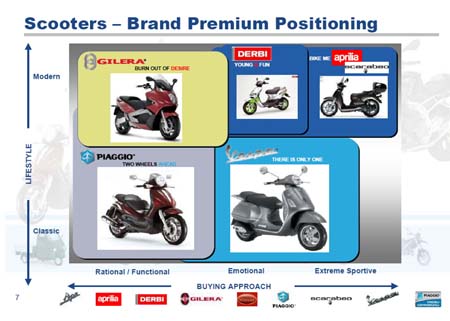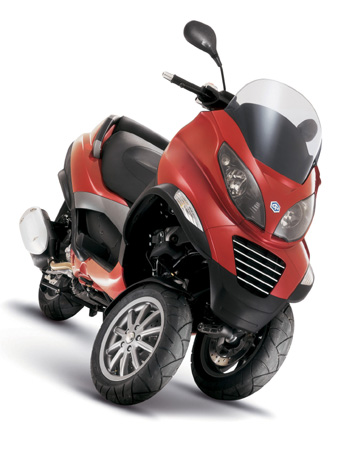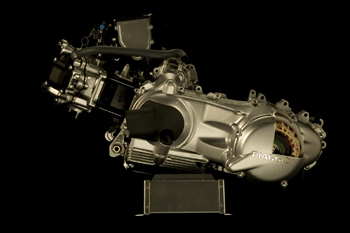Executive VP of Piaggio Talks at Length About Group's Plans in Asia
2008/10/20 | By Quincy LiangLeonardo Caputo, executive vice president of Piaggio Group, the largest powered two-wheeler (PTW) conglomerate in Europe, spoke in detail on the topic "Piaggio Group, the Asian Challenge" during the 3rd Taiwan International Motorcycle Industry Show (Motorcycle Taiwan 2008) show held early April this year in Taipei, with the extensive presentation focusing on three major themes: the Piaggio Group overview, Piaggio Group strategic guidelines, and Piaggio Group in Asia.
TAITRA, organizer of the Motorcycle Taiwan 2008, apparently succeeded in its purpose-planting the seed of even bigger prospects for the PTW sector in Asia-and attracted a capacity crowd with Caputo's presentation, which detailed the big PTW group's strategic, product plans in Asia, the world's most important PTW market where about 80% of global PTW products are sold.
Piaggio's Core Strength
Piaggio is one of the most important international players in the light mobility segment, Caputo says, and the group is engaged in three lines of products, including scooters, motorcycles, three- and four-wheeled light commercial vehicles (LCVs), with a presence in over 50 countries. Piaggio operates via a wide commercial network (with a direct presence in Europe, North America, mainland China, India, Japan), which are supported by eight production plants in Europe, China, and India.
Piaggio's product strength is readily visible from its key figures in 2007: nine brands; a total of 860,000 vehicles produced worldwide; 710,000 vehicles sold; annual revenue of 1.7 billion euro; eight global production plants; five R&D centers worldwide; 6,850 employees and 13,500 worldwide dealers; 15 global subsidiaries; and 50 markets.
Major Products
With three main product lines-scooters, motorcycles, and LCVs-Piaggio offers a full range of scooters displacing 50 to 800cc, which are marketed under six brands: Piaggio, Vespa, Gilera, Aprilia, Scarabeo, and Derbi, placing the group as the market leader in Europe. Piaggio also offers motorcycles displacing 50cc to 1200cc, and is the European market leader in 50cc to 125cc bikes. The group also has road-going, touring, and off-road PTWs in the high-displacement segments, which are marketed under four brands-Aprilia, Moto Guzzi, Derbi, and Gilera. It also offers three/four-wheeled vehicles for utility and personal mobility, and is the sole European player in such niche markets. Plus Piaggio is the No. 2 supplier of three-wheeled PTWs in India, which are marketed under Ape, Porter, and Quargo brands.
Piaggio is distinctive for its unique, premium brand portfolio and clear market differentiation and positioning, Caputo claims, as well as being the leader in urban mobility. Its Gilera branded PTWs focuses on sport riders from teenagers to more sophisticated users; the world-renowned Vespa a unique and inimitable lifestyle scooter that is also popular for the young; Ape-branded LCVs offer an option for urban mobility; Moto Guzzui is one of the hallmark brands for cruiser motorbikes; Aprilia is a brand of specialist motorcycles and sophisticated scooters featuring innovation, performance, and distinctively Italian design; Scarabeo is a unique line of scooters with motorcycle-like dynamics and technical content; while Derbi is the benchmark in the lightweight bike segment for young riders.

Piaggio's Solutions
"There are some big global challenges for the transportation equipment industries, specially traffic, safety, and pollution issues," Caputo says, "toward which Piaggio is using its strengths, including technological innovation, quality, and design, to confront and map out ideal solutions."
For urban mobility, the executive vice president points out, Piaggio has been focusing on developing newer, better products designed for intra-city travel, within a radius of 40 kilometers. In major European cities, for example, Caputo further explains, PTWs have many advantages and benefits over cars: about 50% shorter travel time; up to 65% less fuel consumption; up to even 75% lesser output in CO2 emissions; considerable savings in "congestion charges" in London for example; and an average saving of 1,400 euro in the EcoPass in Milan etc.
Caputo adds that Piaggio has been utilizing its advanced technical strength to introduce safer and more advanced products for upgraded safety: for example, the group launched the MP3 three-wheeled scooter, and PTWs equipped with anti-lock brakes (ABS)/traction control system (TCS) over the past few years.
Being green, Caputo claims, also has been one of Piaggio's goals, having successfully taken the lead to launch the hybrid scooter engine technology that would be equipped on the MP3 by the end of the year, as well as other green solutions for its LCVs.
Hybrid Technology
Piaggio has adopted a versatile hybrid engine system, enabling riders to choose from driving the rear wheel simultaneously with the traditional gasoline-powered engine and electric motor, or separately; while other advantages include charging the battery of the motor system either by the gasoline engine or a wall outlet; recharging the battery via regenerative braking and deceleration; and electric-drive-only mode.
The hybrid powertrain enables a vehicle to greatly save fuel consumption and reduce CO2 emissions; boost performance by up-to-85% by combining the two power plants; and an up-to-20 kilometer driving range in electric-only mode.

Piaggio in Asia
Asia is without doubt the most important market for PTW makers: In 2007, a total of 41.4 million PTWs were sold globally, generating 48 billion euro in sales at an average unit price of 1,160 euro, of which Asia accounted for 80.2% of the total world sales at 33.2 million units, and 44.9% of the total sales value or 21.5 billion euro.
"The Asiatic region has contributed to Piaggio Group's success in the past, and it represents our new growth opportunity and the next step of our Globalization Strategy, together with consolidation in Europe and further exploration of the Americas," claims Caputo.
Currently, Piaggio's Asian operations span across India, China, Vietnam, Singapore and Japan:
India: 100%-owned subsidiary PVPL for making LTVs at one factory in Bharamathi for local and export sales.
China: a joint venture, Zongshen Piaggio Foshan Motocycles Co. Ltd., or ZPFM, to locally produce scooters and motorcycles at one plant in Fujian Province.
Vietnam: a 100%-owned subsidiary Piaggio Vietnam is scheduled to begin scooter production in 2009 at a plant being built in Hanoi.
Japan: a trading company.
Singapore: a trading office.
"In Asia, Piaggio is a new organization with a new challenge," the vice president says. "We are a new organization in the region to consolidate and develop new markets for both two- and three/four-wheeled products, as well as to find sourcing opportunities. Besides focusing on four geographic areas, including India, China, Vietnam and Japan, we are also actively working on building a network of production plants, specializing in various businesses and geographic areas, reaching new agreements with key partners, setting up new R&D centers, and new purchasing offices."
2007 Performance
Caputo claims that in 2007 the Piaggio Indian plant in Baramati started producing 1,000cc and 1,20cc diesel engines for LTVs, gasoline engines for scooters, and assembled scooters. The next step for Piaggio is to scout two-wheeled product opportunities in India, leveraging on Italian design and new technologies, including the Vespa hybrid scooter.
ZPFM (a joint venture between Zongshen Group and Piaggio Group) was set up in China in 1994 and restructured in 2004. The scope of the joint-venture agreement, according to Caputo, includes improving Piaggio Group's global sourcing capabilities, cultivate the "value for money" European Market, and grow in the Chinese two-wheeled market, currently the largest PTW market in global volume by accounting for nearly 16 million units in 2007. In addition, he adds, the agreement provides for Zongshen Group to offer experience, know-how to acquire components, production and sales capacity in the Chinese market, with the Piaggio Group offering technology, R&D capabilities, quality control, assistance in product engineering etc.
In the world's largest PTW market, Caputo says, Piaggio's strategic guidelines include first, to enter into the low-cost European PTW market segment by buying back products produced in China; second, to gain a foothold in the important market; and third, to access local suppliers to enable them to join Piaggio's global sourcing project.
Goal in Vietnam
Piaggio's major goals for its Vietnam investment project, according to Caputo, aims to locally produce and commercialize Vespa-branded vehicles, leveraging on Italian design and quality on the one hand, and realize lucrative opportunities in the booming Vietnam market by tapping benefits as lower costs and import-tax reduction via local production. A perhaps more important goal is to create a production base to serve the rapidly growing Association of Southeast Asian Nations (ASEAN) market, as well as set up a potential opportunity to enable Piaggio's buy-back strategy option.

Vietnam promises to be a market of excellent potential, the vice president says, as 2.5 million units of PTWs were sold in 2007 and the figure is expected to soar to 3.5 million by 2013. The market strength and continuous growth of a brand, however, he adds, is based upon perceiving the population, either urban or rural, positively or as potential customers at any income level.
"Brand, quality, design, and image are the key selling factors in the Vietnam market for all segments and at any price level," Caputo says. "With the current road conditions or transportation infrastructure in Vietnam, cars are highly unlikely to replace PTWs in the near future. The forecast is that PTWs are expected to remain, until 2020, the major transportation vehicle in the nation."




